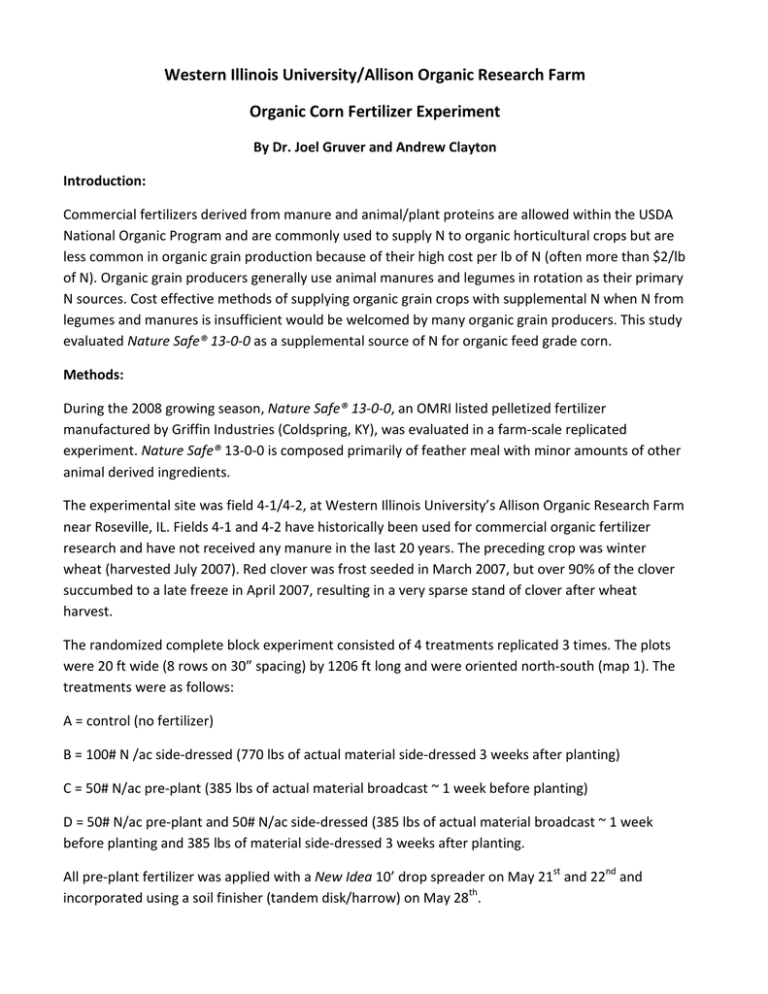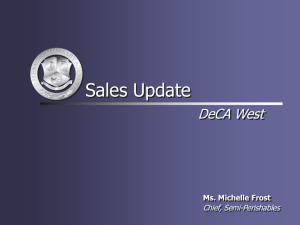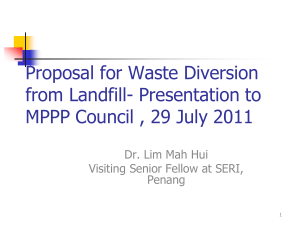Western Illinois University/Allison Organic Research Farm Organic Corn Fertilizer Experiment
advertisement

Western Illinois University/Allison Organic Research Farm Organic Corn Fertilizer Experiment By Dr. Joel Gruver and Andrew Clayton Introduction: Commercial fertilizers derived from manure and animal/plant proteins are allowed within the USDA National Organic Program and are commonly used to supply N to organic horticultural crops but are less common in organic grain production because of their high cost per lb of N (often more than $2/lb of N). Organic grain producers generally use animal manures and legumes in rotation as their primary N sources. Cost effective methods of supplying organic grain crops with supplemental N when N from legumes and manures is insufficient would be welcomed by many organic grain producers. This study evaluated Nature Safe® 13-0-0 as a supplemental source of N for organic feed grade corn. Methods: During the 2008 growing season, Nature Safe® 13-0-0, an OMRI listed pelletized fertilizer manufactured by Griffin Industries (Coldspring, KY), was evaluated in a farm-scale replicated experiment. Nature Safe® 13-0-0 is composed primarily of feather meal with minor amounts of other animal derived ingredients. The experimental site was field 4-1/4-2, at Western Illinois University’s Allison Organic Research Farm near Roseville, IL. Fields 4-1 and 4-2 have historically been used for commercial organic fertilizer research and have not received any manure in the last 20 years. The preceding crop was winter wheat (harvested July 2007). Red clover was frost seeded in March 2007, but over 90% of the clover succumbed to a late freeze in April 2007, resulting in a very sparse stand of clover after wheat harvest. The randomized complete block experiment consisted of 4 treatments replicated 3 times. The plots were 20 ft wide (8 rows on 30” spacing) by 1206 ft long and were oriented north-south (map 1). The treatments were as follows: A = control (no fertilizer) B = 100# N /ac side-dressed (770 lbs of actual material side-dressed 3 weeks after planting) C = 50# N/ac pre-plant (385 lbs of actual material broadcast ~ 1 week before planting) D = 50# N/ac pre-plant and 50# N/ac side-dressed (385 lbs of actual material broadcast ~ 1 week before planting and 385 lbs of material side-dressed 3 weeks after planting. All pre-plant fertilizer was applied with a New Idea 10’ drop spreader on May 21st and 22nd and incorporated using a soil finisher (tandem disk/harrow) on May 28th. All side-dress fertilizer was applied on June 17th and 18th with an EarthWay® 2’ broadcast spreader designed for home turf management. Shields were attached to the sides of the EarthWay® spreader to prevent application outside of the intended row. Fertilizer was incorporated by the subsequent row crop cultivation. The experiment was planted on May 29 using a 16 row Case IH 1200 Air Flow planter. The corn was planted 2” deep with a population of 28,000 seeds/ac. The entire experiment was planted to Prairie Hybrids 3081 (104 days maturity). Weed control was achieved by rotary hoeing on June 2nd and June 11th and a single, row cultivation on June 18th using a Buffalo 4 row cultivator. Wet weather conditions prohibited any subsequent row cultivations. Plots were harvested with a John Deere STS combine on 11/5/08. Yields were obtained using a yield monitor with correction based on yield monitor/weigh wagon relationships from another field. Corn stands were estimated by counting the number of stalks in each plot for three 17.6’ lengths of row. Stand counts were performed post harvest on the south end of the plots. Results: Treatment D obtained the highest yields, which also was apparently the most consistent uniform yielding treatment (map 1). All three fertilizer treatments produced significantly higher yields than the control (no fertilizer) treatment (table 1). Yields for the fertilizer treatments were not significantly different with α set at 0.05 (95% confidence). With α set at 0.20 (80% confidence) treatment D, which received 100 lbs of N/ac, had significantly higher yields than treatment C, which received only 50 lbs of N/ac (table 1). Map 1: Yields for all plots N↑ R= 113 bu/a X= 110 bu/a B= 149 bu/a A= 131 bu/a C= 148 bu/a D= 159 bu/a C= 151 bu/a A= 148 bu/a D= 153 bu/a B= 155 bu/a D= 155 bu/a C = 142 bu/a B= 152 bu/a A= 121 bu/a X= 132 bu/a Note: Each 8 row round/ treatment on the map above is represented by alternating colors and each treatment by a letter ID. Treatments: A = control (no fertilizer), B = 100#/ac N side-dressed when corn was 12-16” tall, C = 50#/ac N pre-plant, D = 50#/ac N pre-plant and 50#/ac N side-dressed post planting for a total 100#/ac N, R = fair stand of forage radish untouched in the fall and allowed to winter-kill (one rep to observe), X = buffer (no fertilizer) Table1: Impact of Nature Safe (13-0-0) treatments on corn yield Organic Fertilizer Treatment Treatment means (Bu/ac) D- 50# N/ac pre-plant and 50# N/ac 155.8a N side-dressed ~ 3 weeks after planting for a total 100# N/ac B- 100# N/ac side-dressed ~ 3 152.1a weeks after planting Treatment means (Bu/ac) 155.8a Rank 152.1a b 2 1 C- 50# N/ac N pre-plant 147.2 a 147.2 b 3 A- control (no fertilizer) 133.1b 133.1c 4 LSD (0.05) = 13.9 LSD (0.20) = 8.4 Discussion: Is Nature Safe 13-0-0 a cost effective source of N for use in organic feed grade corn production? Nature Safe 13-0-0 cost $700/ton (includes freight) in the spring of 2008 which is equivalent to $2.69 per lb of N. In comparison with the price per lb of N from legume cover crops, manure, or bulk byproducts available for animal feeding (tables 3, 4 & 5) $2.69 per lb of N is a high price. In comparison with other commercial organic N sources (e.g., Chilean nitrate), $2.69 is a competitive price. The convenience of a dry stable pelletized material with consistent composition and high N availability has considerable value. Table 2, below, illustrates the economics of using this organic fertilizer in organic corn production. Table 2: Economic impact of Nature Safe (13-0-0) treatments Organic Fertilizer Treatment Corn Yield (Bu/ac) Organic Fertilizer Cost per Acre** Total Income Realized per Acre Income Gain/(Loss) Vs. control 155.8a Gross Corn Sales per Acre @ $10.50/bu * $1,636 D- 50#/ac N preplant and 50#/ac N side-dressed post planting for a total 100#/ac N B- 100#/ac N sidedressed when corn was 12-16” tall C- 50#/ac N preplant $277 $1,359 ($39) 152.1a $1,597 $273 $1,324 ($74) 147.2 a $1,546 $139 $1,407 $9 $0 $1,398 N/A A- control 133.1b $1,398 (no fertilizer) *Price paid by Clarkson Grain Co., Inc. in fall 2008. ** Includes application costs of $3.75/ac+ per 2008 Iowa Farm Custom Rate Survey. Table 3: Nitrogen value of manure Animal manure lbs N/ton Liquid Hog1 Poultry Litter compost2 9.4 56 $ Price per ton $2.38 $95 $/lb of N $/lb of N* $0.25 $1.69 --negative-$0.27 Application cost per ton $4.76 $6 Cost of 100 lbs of N/acre applied $75.96 $180.35 * P2O5 and K2O discounted at $0.50/lb P2O5 and $0.50/lb K2O, for the hog manure this discount is actually greater than the total value of the manure @ $10/1000 gal) 1) L. Tappe farm finishing house manure (assumes 8.5 lbs/gallon, a material cost of $10/1000 gallons and a $23/1000 gallon application cost) 2) Pearl Valley Organics (Pearl City, IL) per communication with Andy Thompson Table 4: Nitrogen value of legumes Legume $/lb seed Seeding rate lb/acre Redclover1 $3.66 10 Hairy vetch2 $2.20 25 1) Source Welter Seed and Honey 2) Source Welter Seed and Honey Total management costs/acre $31.50* $22.30** Typical lbs of N fixed per acre – Cost of 1 lb of N/acre fixed 80 100 $0.85 $0.77 * frost seeding, one mowing to control weeds, disking ** drilling, disking Table 5: Nitrogen value feed by-products Protein concentrates % Protein lbs of N content per ton $ Price per ton Feathermeal1 85 272 450 Bloodmeal1 80 256 600 Soybeanmeal1 47.5 152 281 Corn Gluten Feed1 21.5 69 100 * no charge for application or discount for P2O5 and K2O $/lb of N* $/lb of N** $1.65 $2.34 $1.85 $1.45 $1.65 $2.34 $1.31 $0.91 Cost of 100 lbs of N/acre applied*** $169 $238 $189 $149 ** no charge for application, but P2O5 and K2O discounted at $0.50/lb P2O5 and $0.50/lb K2O assuming 65 lbs of P2O5 and 100 lbs of K2O per ton of soybean meal and 41 lbs of P2O5 and 34 lbs of K2O per ton of corn gluten feed *** application cost included ($4/ac per 2008 Iowa farm Custom Rate Survey), no discount for P2O5 and K2O 1) University of Missouri Extension “By-Product Feed Price Listing” 2008 online values http://agebb.missouri.edu/dairy/byprod/bplist.asp Summary: All of the fertilizer treatments evaluated in this study resulted in significant yield improvement but only one 50#/ac N (385# of actual material) applied pre-plant resulted in net profit at the corn : fertilizer price ratio ($10.50/bu:$700/ton NS 13-0-0) experienced during the study. It should be noted that the price of organic corn increased dramatically to an all time high during the 2008 growing season leading to an unusually favorable grain price: fertilizer price ratio. The growing season (2008) had unusually consistent rainfall after a dry start to the season. This may have resulted in higher than average mineralization of SOM- N which could have reduced crop response to the added N. Crops grown on soils with less mineralization potential, during growing seasons less conducive to mineralization of SOM-N or planted earlier would likely respond more to applications of Nature Safe (13-0-0) fertilizer than was observed this season at this site. In conclusion, the best return on investment in a relatively expensive fertilizer product like Nature Safe (13-00) is likely to occur when relatively low rates of N are applied in combination with lower cost N sources. The treatment with the lowest rate in this study was the one profitable treatment but it is quite possible that an even lower rate would have been more profitable.

![Questions for (3.3.3) Externalities in agriculture [True or False?] The](http://s2.studylib.net/store/data/009995147_1-f1de64b535b6f4b8fe06925685d00ca4-300x300.png)




